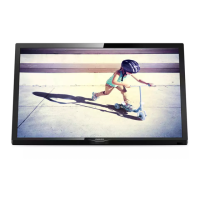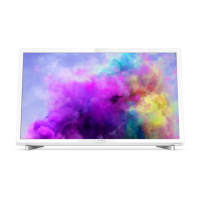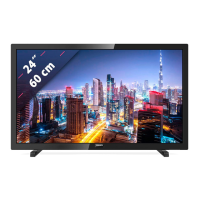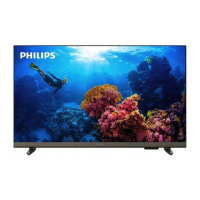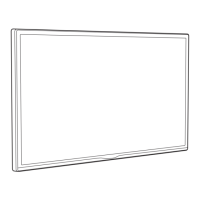Do you have a question about the Philips 24PFT4022 and is the answer not in the manual?
Steps to update TV software via USB or OAD.
Remote control batteries, cleaning, and key functions.
Importance of reading safety instructions before TV use.
How to connect the power cable and turn on the TV.
Connecting audio devices via HDMI ARC and Optical.
Using USB flash drives and hard drives for media and recording.
Installing channels via antenna, cable, or satellite.
Opening, navigating, and using the TV guide features.
Requirements for pausing and recording TV broadcasts.
How to pause and resume live TV broadcasts.
General information about recording digital TV broadcasts.
Accessing media files from USB devices connected to the TV.
Adjusting sound style, bass, treble, and headphone volume.
Adjusting picture quality settings.
Resetting TV to factory settings and reinstalling.
Overview of rear and side connections for different TV models.
General troubleshooting tips and resources for solving TV problems.
Troubleshooting steps when the TV does not switch on.
Troubleshooting issues with the TV not responding to the remote control.
Troubleshooting common picture problems like no picture or distortion.
Troubleshooting sound issues like no sound or poor quality.
Important safety instructions to prevent electric shock, fire, injury, or damage.
Steps to update TV software via USB or OAD.
Remote control batteries, cleaning, and key functions.
Importance of reading safety instructions before TV use.
How to connect the power cable and turn on the TV.
Connecting audio devices via HDMI ARC and Optical.
Using USB flash drives and hard drives for media and recording.
Installing channels via antenna, cable, or satellite.
Opening, navigating, and using the TV guide features.
Requirements for pausing and recording TV broadcasts.
How to pause and resume live TV broadcasts.
General information about recording digital TV broadcasts.
Accessing media files from USB devices connected to the TV.
Adjusting sound style, bass, treble, and headphone volume.
Adjusting picture quality settings.
Resetting TV to factory settings and reinstalling.
Overview of rear and side connections for different TV models.
General troubleshooting tips and resources for solving TV problems.
Troubleshooting steps when the TV does not switch on.
Troubleshooting issues with the TV not responding to the remote control.
Troubleshooting common picture problems like no picture or distortion.
Troubleshooting sound issues like no sound or poor quality.
Important safety instructions to prevent electric shock, fire, injury, or damage.
| Screen shape | Flat |
|---|---|
| Response time | - ms |
| Display diagonal | 24 \ |
| Display brightness | 250 cd/m² |
| Display technology | LED |
| Native aspect ratio | 16:9 |
| Peak luminance ratio | 65 % |
| Supported video modes | 1080p |
| Display diagonal (metric) | 60 cm |
| Screen format adjustments | 4:3, 16:9, Auto, Zoom |
| Supported graphics resolutions | 1920 x 1080 (HD 1080) |
| Motion interpolation technology | - |
| 3D | No |
| Battery type | AAA |
| Annual energy consumption | 31 kWh |
| RF connector type | IEC |
| USB 2.0 ports quantity | USB 2.0 ports have a data transmission speed of 480 Mbps, and are backwards compatible with USB 1.1 ports. You can connect all kinds of peripheral devices to them. |
| S-Video inputs quantity | 0 |
| Digital audio optical out | 1 |
| Programming period | 8 day(s) |
| Firmware upgradeable via | Auto upgrade wizard, USB |
| Tuner type | Analog & digital |
| Analog signal format system | NTSC, PAL, SECAM |
| Digital signal format system | DVB-C, DVB-T, DVB-T2 |
| Product color | Black |
| Mercury content | 0 mg |
| Heavy metals free | Hg (mercury) |
| Panel mounting interface | 75 x 75 mm |
| RMS rated power | 6 W |
| AC input voltage | 220 - 240 V |
| AC input frequency | 50 - 60 Hz |
| Power consumption (standby) | 0.3 W |
| Power consumption (typical) | 21 W |
| Operating temperature (T-T) | 5 - 35 °C |
| Audio formats supported | AAC, MP3, WAV, WMA |
| Image formats supported | BMP, GIF, JPG, PNG |
| Video formats supported | AVI, H.264, MKV, MPEG1, MPEG2, MPEG4, VC-1, WMV9 |
| Subtitle formats supported | ASS, SMI, SRT, SSA, SUB, TXT |
| Package type | Box |
| Package depth | 112 mm |
| Package width | 630 mm |
| Package height | 425 mm |
| Package weight | 4600 g |
| Cables included | AC |
| Depth (with stand) | 118.07 mm |
|---|---|
| Height (with stand) | 340.37 mm |
| Weight (with stand) | 3270 g |
| Depth (without stand) | 38.4 mm |
| Width (without stand) | 562.3 mm |
| Height (without stand) | 336.63 mm |
| Weight (without stand) | 3220 g |

